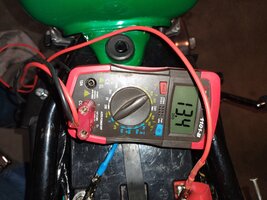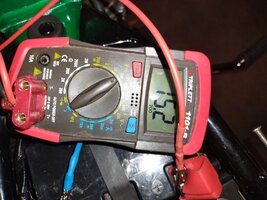gruvola
XS650 Member
Greetings! I did a frame off resto on this about 5 years ago. Carbs and ignition run beautifully (both are original). But, been chasing charging system gremlins pretty much this bike's life before and after, able to ride 20-30 miles but battery drains. Embarrassed how many parts I've thrown at it. Here's the short version. Stator resistance 0.6 ohms on each of the three pairs, but showing only 20 ohms resistance on each wire to ground (which is weird - would have guessed either shorted or much more). Stator/charging test while running shows AC voltage consistent for each pair, starting below 10 volt AC at idle and climbing to 20 volt AC at 3k rpm (above 3k, it did the center stand scoot and I couldn't hold on to it!).
Battery is older but checks out with load test, etc. Voltage across battery is about 13 fully charged, drops to 12.75 with key and headlight on. Starts fine. Then sometimes, it will hold voltage about 12.5 at idle and then jump to 14 at 3k intermittently. But often voltage jumps badly or never climbs above 13. Importantly, I found I had a short in my negative battery cable which I replaced. Did this knock out the reg/rect?
So . . . Do I have a short between the stator and ground (all three stator wires to ground are only 20 ohm to ground)? Are the rotor and/or stator compromised? Do I spring for (yet) another reg/rect, suspecting I fried it due to the bad ground? Or, do I go all Hugh's hand built up on the deal?
Any help is appreciated. Be kind, I'm no genius.




